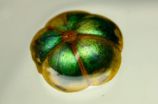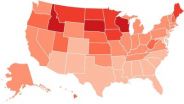(Press-News.org) Cambridge, Mass. – January 28, 2013 - A team of materials scientists at Harvard University and the University of Exeter, UK, have invented a new fiber that changes color when stretched. Inspired by nature, the researchers identified and replicated the unique structural elements that create the bright iridescent blue color of a tropical plant's fruit.
The multilayered fiber, described today in the journal Advanced Materials, could lend itself to the creation of smart fabrics that visibly react to heat or pressure.
"Our new fiber is based on a structure we found in nature, and through clever engineering we've taken its capabilities a step further," says lead author Mathias Kolle, a postdoctoral fellow at the Harvard School of Engineering and Applied Sciences (SEAS). "The plant, of course, cannot change color. By combining its structure with an elastic material, however, we've created an artificial version that passes through a full rainbow of colors as it's stretched."
Since the evolution of the first eye on Earth more than 500 million years ago, the success of many organisms has relied upon the way they interact with light and color, making them useful models for the creation of new materials. For seeds and fruit in particular, bright color is thought to have evolved to attract the agents of seed dispersal, especially birds.
The fruit of the South American tropical plant, Margaritaria nobilis, commonly called "bastard hogberry," is an intriguing example of this adaptation. The ultra-bright blue fruit, which is low in nutritious content, mimics a more fleshy and nutritious competitor. Deceived birds eat the fruit and ultimately release its seeds over a wide geographic area.
"The fruit of this bastard hogberry plant was scientifically delightful to pick," says principal investigator Peter Vukusic, Associate Professor in Natural Photonics at the University of Exeter. "The light-manipulating architecture its surface layer presents, which has evolved to serve a specific biological function, has inspired an extremely useful and interesting technological design."
Vukusic and his collaborators at Harvard studied the structural origin of the seed's vibrant color. They discovered that the upper cells in the seed's skin contain a curved, repeating pattern, which creates color through the interference of light waves. (A similar mechanism is responsible for the bright colors of soap bubbles.) The team's analysis revealed that multiple layers of cells in the seed coat are each made up of a cylindrically layered architecture with high regularity on the nano- scale.
The team replicated the key structural elements of the fruit to create flexible, stretchable and color-changing photonic fibers using an innovative roll-up mechanism perfected in the Harvard laboratories.
"For our artificial structure, we cut down the complexity of the fruit to just its key elements," explains Kolle. "We use very thin fibers and wrap a polymer bilayer around them. That gives us the refractive index contrast, the right number of layers, and the curved, cylindrical cross-section that we need to produce these vivid colors."
The researchers say that the process could be scaled up and developed to suit industrial production.
"Our fiber-rolling technique allows the use of a wide range of materials, especially elastic ones, with the color-tuning range exceeding by an order of magnitude anything that has been reported for thermally drawn fibers," says coauthor Joanna Aizenberg, Amy Smith Berylson Professor of Materials Science at Harvard SEAS, and Kolle's adviser. Aizenberg is also Director of the Kavli Institute for Bionano Science and Technology at Harvard and a Core Faculty Member at the Wyss Institute for Biologically Inspired Engineering at Harvard.
The fibers' superior mechanical properties, combined with their demonstrated color brilliance and tunability, make them very versatile. For instance, the fibers can be wound to coat complex shapes. Because the fibers change color under strain, the technology could lend itself to smart sports textiles that change color in areas of muscle tension, or that sense when an object is placed under strain as a result of heat.
INFORMATION:
Additional coauthors included Alfred Lethbridge at the University of Exeter, Moritz Kreysing at Ludwig Maximilians University (Germany), and Jeremy B. Baumberg, Professor of Nanophotonics at the University of Cambridge (UK).
This research was supported by the U.S. Air Force Office of Scientific Research Multidisciplinary University Research Initiative, by the UK Engineering and Physical Sciences Research Council, and through a postdoctoral research fellowship from the Alexander von Humboldt Foundation. The researchers also benefited from facilities at the Harvard Center for Nanoscale Systems, which is part of the National Nanotechnology Infrastructure Network supported by the U.S. National Science Foundation.
Bioinspired fibers change color when stretched
Color-tunable photonic fibers mimic the fruit of the 'bastard hogberry' plant
2013-01-29
ELSE PRESS RELEASES FROM THIS DATE:
Innovative uses of nanotechnology in food and agriculture
2013-01-29
New Rochelle, NY, January 28, 2013—The U.S. Department of Agriculture (USDA) invests nearly $10 million a year to support about 250 nanoscale science and engineering projects that could lead to revolutionary advances in agriculture and food systems. Examples of current projects in development are presented in a Special Research Section published in Industrial Biotechnology, a peer-reviewed journal from Mary Ann Liebert Inc., publishers. The articles are available on the Industrial Biotechnology website.
In their introductory article, "Overview: Nanoscale Science and ...
Skin, soft tissue infections succumb to blue light
2013-01-29
Blue light can selectively eradicate Pseudomonas aeruginosa infections of the skin and soft tissues, while preserving the outermost layer of skin, according to a proof-of-principle study led by Michael R. Hamblin of the Massachusetts General Hospital, and the Harvard Medical School, Boston. The research is published online ahead of print in the journal Antimicrobial Agents and Chemotherapy
"Blue light is a potential non-toxic, non-antibiotic approach for treating skin and soft tissue infections, especially those caused by antibiotic resistant pathogens," says Hamblin. ...
Injecting botox into stomach does not promote weight loss
2013-01-29
Bethesda, MD (Jan. 28, 2013) – Despite conflicting data in support of the practice, some overweight Americans looking for an easy fix have turned to gastric botox injections to help them lose weight. This month in Clinical Gastroenterology and Hepatology, the official clinical practice journal of the American Gastroenterological Association, researchers from the Mayo Clinic publish a definitive study finding that Botox doesn't promote weight loss.
Injecting botulinum toxin A (BTA), or Botox, into the stomach had been believed to delay emptying of the stomach, increase ...
New study shows stable fisher population in the Southern Sierra Nevada
2013-01-29
ARCATA, Calif.—After experiencing years of population decline on the West Coast, a recent study examining fisher populations found that—at least in the southern Sierra Nevada—the animal's numbers appear to be stable.
Scientists from the U.S. Forest Service's Pacific Southwest Research Station (PSW) and the Pacific Southwest Region collaborated to monitor the distribution of fishers across a 7,606-square-mile area in the southern Sierra Nevada. They used baited track-plate stations—an enclosure where the fisher leaves a sooted track print as it walks through—at 223 locations ...
Using Twitter to track the flu: A better way to screen the Tweets
2013-01-29
Sifting through social media messages has become a popular way to track when and where flu cases occur, but a key hurdle hampers the process: how to identify flu-infection tweets. Some tweets are posted by people who have been sick with the virus, while others come from folks who are merely talking about the illness. If you are tracking actual flu cases, such conversations about the flu in general can skew the results.
To address this problem, Johns Hopkins computer scientists and researchers in the university's School of Medicine have developed a new tweet-screening ...
Climate change projected to alter Indiana bat maternity range
2013-01-29
Research by US Forest Service scientists forecasts profound changes over the next 50 years in the summer range of the endangered Indiana bat. In an article published in the journal Ecology and Evolution, Forest Service Southern Research Station researchers Susan Loeb and Eric Winters discuss the findings of one of the first studies designed to forecast the responses of a temperate zone bat species to climate change.
The researchers modeled the current maternity distribution of Indiana bats and then modeled future distributions based on four different climate change scenarios. ...
New look at cell membrane reveals surprising organization
2013-01-29
LIVERMORE, CALIF. — A new way of looking at a cell's surface reveals the distribution of small molecules in the cell membrane, changing the understanding of its organization.
A novel imaging study by researchers from Lawrence Livermore National Laboratory, the University of Illinois and the National Institutes of Health revealed some unexpected relationships among molecules within cell membranes.
Their findings provide a new way of studying cell structure and ultimately its function.
Led by Mary Kraft of the University of Illinois, Peter Weber of Lawrence Livermore ...
Eating bright-colored fruits and vegetables may prevent or delay ALS
2013-01-29
New research suggests that increased consumption of foods containing colorful carotenoids, particularly beta-carotene and lutein, may prevent or delay the onset of amyotrophic lateral sclerosis (ALS). The study, published by Wiley in Annals of Neurology, a journal of the American Neurological Association and Child Neurology Society, found that diets high in lycopene, beta-cryptoxanthin, and vitamin C did not reduce ALS risk.
Carotenoids give fruits and vegetables their bright orange, red, or yellow colors, and are a source of dietary vitamin A. Prior studies report that ...
Scientists trick iron-eating bacteria into breathing electrons instead
2013-01-29
Scientists have developed a way to grow iron-oxidizing bacteria using electricity instead of iron, an advance that will allow them to better study the organisms and could one day be used to turn electricity into fuel. The study will be published on January 29 in mBio®, the online open-access journal of the American Society for Microbiology.
The method, called electrochemical cultivation, supplies these bacteria with a steady supply of electrons that the bacteria use to respire, or "breathe". It opens the possibility that one day electricity generated from renewable sources ...
Early menopause may occur in women with BRCA gene, new study finds
2013-01-29
Women with harmful mutations in the BRCA gene, which put them at higher risk of developing breast and ovarian cancer, tend to undergo menopause significantly sooner than other women, allowing them an even briefer reproductive window and possibly a higher risk of infertility, according to a study led by researchers at UC San Francisco.
Moreover, the study showed that carriers of the mutation who are heavy smokers enter menopause at an even earlier age than non-smoking women with the mutation.
While the authors note that further research is needed, given the size and ...
LAST 30 PRESS RELEASES:
Air pollution exposure and birth weight
Obstructive sleep apnea risk and mental health conditions among older adults
How talking slows eye movements behind the wheel
The Ceramic Society of Japan’s Oxoate Ceramics Research Association launches new international book project
Heart-brain connection: international study reveals the role of the vagus nerve in keeping the heart young
Researchers identify Rb1 as a predictive biomarker for a new therapeutic strategy in some breast cancers
Survey reveals ethical gaps slowing AI adoption in pediatric surgery
Stimulant ADHD medications work differently than thought
AI overestimates how smart people are, according to HSE economists
HSE researchers create genome-wide map of quadruplexes
Scientists boost cell "powerhouses" to burn more calories
Automatic label checking: The missing step in making reliable medical AI
Low daily alcohol intake linked to 50% heightened mouth cancer risk in India
American Meteorological Society announces Rick Spinrad as 2026 President-Elect
Biomass-based carbon capture spotlighted in newly released global climate webinar recording
Illuminating invisible nano pollutants: advanced bioimaging tracks the full journey of emerging nanoscale contaminants in living systems
How does age affect recovery from spinal cord injury?
Novel AI tool offers prognosis for patients with head and neck cancer
Fathers’ microplastic exposure tied to their children’s metabolic problems
Research validates laboratory model for studying high-grade serous ovarian cancer
SIR 2026 delivers transformative breakthroughs in minimally invasive medicine to improve patient care
Stem Cell Reports most downloaded papers of 2025 highlight the breadth and impact of stem cell research
Oxford-led study estimates NHS spends around 3% of its primary and secondary care budget on the health impacts of heat and cold in England
A researcher’s long quest leads to a smart composite breakthrough
Urban wild bees act as “microbial sensors” of city health.
New study finds where you live affects recovery after a hip fracture
Forecasting the impact of fully automated vehicle adoption on US road traffic injuries
Alcohol-related hospitalizations from 2016 to 2022
Semaglutide and hospitalizations in patients with obesity and established cardiovascular disease
Researchers ‘listen in’ to embryo-mother interactions during implantation using a culture system replicating the womb lining
[Press-News.org] Bioinspired fibers change color when stretchedColor-tunable photonic fibers mimic the fruit of the 'bastard hogberry' plant



